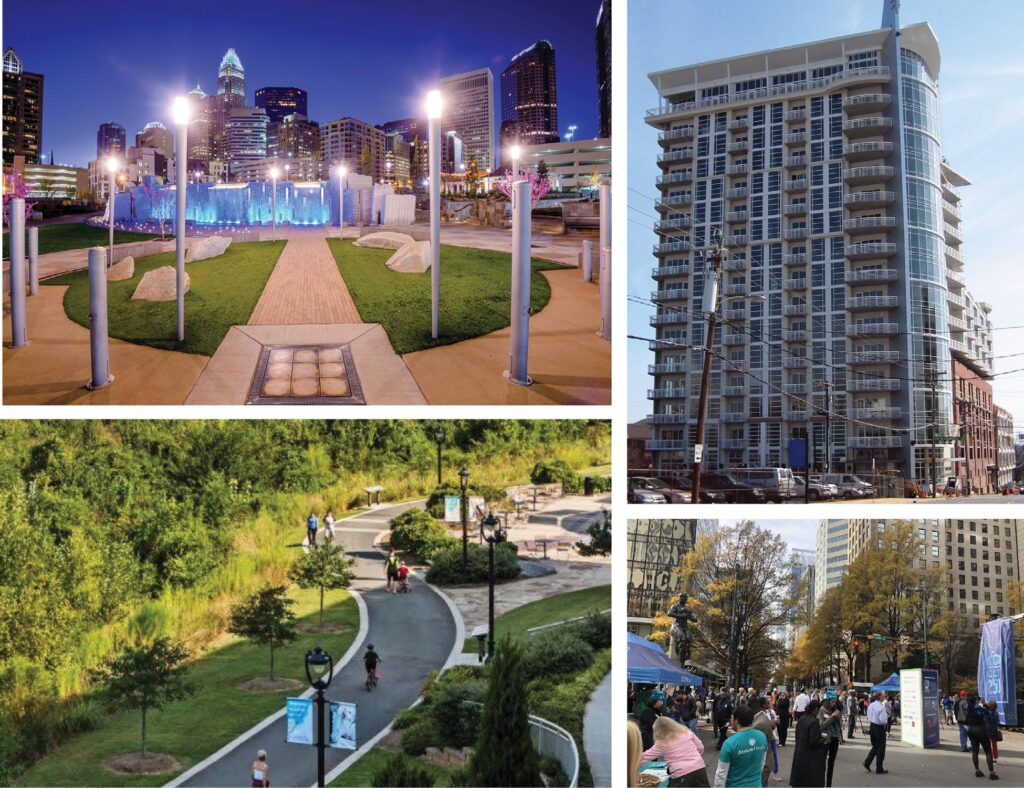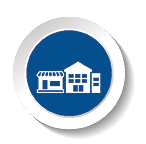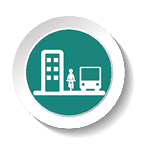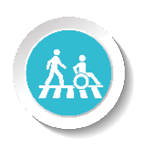Home / C. Goal and Objectives Metrics
Manuals and Metrics
Table of contents
C. Goal and Objectives Metrics

The following provides a suggested list of metrics associated with the objectives corresponding to each of the 10 plan goals in the Comprehensive Plan. The list of metrics should be reviewed to ensure that relevant data is available or can be collected. There are several metrics that will be reported on immediately with already available data and other metrics that should be explored in the future. In addition, a baseline should be established for each metric, as well as 20-year and interim targets.
Goal 1: 10-Minute Neighborhoods

All Charlotte households should have access to essential amenities, goods, and services within a comfortable, tree-shaded 10-minute walk, bike, or transit trip by 2040. Not all neighborhoods are expected to include every essential amenity, good, or service, but every resident should have access within a ½ mile walk or a 2-mile bike or transit ride.
| Objective Number | Objective | Metric |
|---|---|---|
| Increase the percentage of households, both new and existing, within a tree-shaded 10-minute walk, bike, or transit trip of: | Percent of increase to transportation modes. | |
| 1.A | Fresh, healthy food opportunities. | Number of food co-ops, community gardens and neighborhood-based food sharing or grocery store within a 10-minute walk, bike or transit trip |
| 1.B | High performance transit corridor. | Number of facilities within a 10-minute walk, bike or transit trip |
| 1.C | Park, plaza, nature preserve, or other public space. | Number of facilities within a 10-minute walk, bike or transit trip |
| 1.D | Trail, greenway, or other “all ages and abilities (AAA)” bicycle facility. | Number of bicycle facilities, sidewalks, transit stops, parks |
| 1.E | A concentration of daily goods and services (applies to a Neighborhood, Community, or Regional Activity Center). | Number of full-service grocery stores in new mixed use developments in food deserts |
| 1.F | Low-cost health care or pharmacy. | Number of facilities within a 10-minute walk, bike or transit trip |
| 1.G | Community Facilities (libraries, schools, senior centers, community centers, early childhood education etc.). | Percent of vulnerable neighborhoods with increase of facilities; number of facilities built in vulnerable neighborhoods; money spent in vulnerable neighborhoods on facilities; percent of households within a 10-minute trip of early childhood education, library, school, community center |
| 1.H | Financial Services (banks or credit unions). | Number of new financial institutions; percent of households within a 10-minute trip of financial institutions |
| 1.I | Family sustaining wage jobs. | Number of facilities within a 10-minute walk, bike or transit trip |
| 1.J | Advanced technology delivery service and supportive digital access. | Percent of households with advanced technology delivery service |
Goal 2: Neighborhood Diversity and Inclusion

Charlotte will strive for all neighborhoods to have a diversity of housing options by increasing the presence of middle density housing (e.g. duplexes, triplexes, fourplexes, townhomes, accessory dwelling units, and other small lot housing types) and ensuring land use regulations allow for flexibility in creation of housing within neighborhoods.
| Objective Number | Objective | Metric |
|---|---|---|
| 2.A | Increase the score of the overall Access to Housing Opportunity equity metrics index for the City. | Access to Housing Opportunity Equity Metric |
| 2.B | Increase the number of Accessory Dwelling Units (ADUs) in existing and new neighborhoods. | Number of accessory dwelling units |
| 2.C | Increase the number of middle density units such as duplexes, triplexes, in all neighborhoods. | Number of duplexes, triplexes and fourplexes |
| 2.D | Increase the number of middle density housing options, including fourplexes, along high performance transit and other major thoroughfares. | Number of attached single-family units, fourplexes and multifamily units along arterials |
| 2.E | Increase the number of middle density housing options in transition areas between low intensity neighborhoods and higher intensity Place Types. | Number of attached single-family units, fourplexes and multifamily units within 1/8 mile of Activity Centers |
| 2.F | Increase the number of residential dwelling units that includes less than one parking space per unit. | Number of units with less than one parking space |
| 2.G | Increase the number of small footprint housing units in existing and new neighborhoods. | Number of small footprint housing units (see glossary) |
Goal 3: Housing Access for All

Charlotte will ensure opportunities for residents of all incomes to access affordable housing through the preservation of naturally occurring affordable and workforce housing and increasing the number of affordable and workforce housing units through new construction.
| Objective Number | Objective | Metric |
|---|---|---|
| 3.A | Increase housing opportunities for households with limited or no vehicle access by increasing the number of affordable rental and deed-restricted housing units, targeting households at 80% AMI or less, within ½ mile of Activity Centers and high performance transit. | Number of new affordable and workforce units |
| 3.B | Retain the number of naturally occurring affordable and workforce housing units in the community by managing changes within existing neighborhoods. | Number of preserved units |
| 3.C | Increase the number of affordable and workforce units targeting households at 80% AMI or less within mixed-income developments (e.g. affordable and workforce units mixed with market rate units). | Number of new affordable and workforce units |
| 3.D | Reduce the cost burden on households spending more than 45% of their income on housing and transportation. | Number of cost burden households |
| 3.E | Reduce the cost burden on households spending over 30% of household income on housing. | Number of cost burden households |
| 3.F | Increase the number of homeownership opportunities for low to moderate-income households, especially in areas with low Access to Housing Opportunity scores, as identified by the Equitable Growth Framework. | Number of homeownership within specific areas |
| 3.G | Dedicate at least 10% of future housing trust funds to home ownership in areas with low Access to Housing Opportunity scores, as identified by the Equitable Growth Framework. | Percent of funds spent in areas with low Access to Housing Opportunity scores |
| 3.H | Increase housing opportunities and supporting infrastructure and amenities for residents choosing to age in place. | Number of housing units and dollars spent in target areas |
Goal 4: Transit and Trail Oriented Development (2T-OD)

Charlotte will promote moderate to higher-intensity, compact, mixed-use urban development along high-performance transit lines and near separated multi-use pathways or trails.
| Objective Number | Objective | Metric |
|---|---|---|
| 4.A | Increase the percentage of Charlotte households and jobs (new and existing) within ½ mile access to trail access points. | Percent of households within ½ mile of trail access points |
| 4.B | Increase the share of households and jobs with safe access to high performance transit stations (light rail, streetcar, bus rapid transit, and bus routes with headways of 15 min or less during peak hours). | Percent of households and jobs with1/2 mile of high performance transit station |
| 4.C | Increase the share of commercial (mixed use, entertainment, and employment) development within 10-minute tree-shaded walk or bike of trail access points and high-performance transit stations. | Percent of commercial development within ½ mile walk or 2-mile bike of trail access points and high performance transit |
| 4.D | Approach maximum allowable density under the TOD zoning for development within 10-minute walk or bike of trail access points and high-performance transit stations. | Percent built capacity in TOD zoning districts |
| 4.E | Increase the number of moderate to high-intensity developments along regional transit and trail routes. | Number of residential units and square feet of commercial within ½ mile of regional transit and trails |
| 4.F | Increase safe and connected bike infrastructure within two miles of transit stops and trail access points. | Number of miles of designated bike facilities within 2 miles of transit stops and trail access points |
| 4.G | Decrease the percentage of transit stops without access to sidewalks. | Percent of transit stops with complete sidewalk coverage within ½ mile |
| 4.H | Provide signalized pedestrian crossings at all transit stops on thoroughfares. | Percent of transit stops on thoroughfares with signalized pedestrian crossings |
| 4.I | Increase the number of connections between new trail and/or transit line developments and neighborhoods of varying land uses, density, and architecture. | Miles of trail and transit routes within ½ mile of Neighborhood, Community and Regional Activity Centers |
| 4.J | Increase the number of developments that are transit-oriented in both location and design. | Square feet of mixed use development within ½ mile of regional transit and trails |
| 4.K | Create engaging public spaces near high-performance transit stops, stations and trails. | Number of new public spaces |
Goal 5: Safe and Equitable Mobility

Charlotte will provide safe and equitable mobility options for all travelers regardless of age, income, ability, race, where they live, or how they choose to travel. An integrated system of transit and tree-shaded bikeways, sidewalks, trails, and streets will support a sustainable, connected, prosperous, and innovative network that connects all Charlotteans to each other, jobs, housing, amenities, goods, services, and the region.
| Objective Number | Objective | Metric |
|---|---|---|
| 5.A | Eliminate transportation-related fatalities and serious injuries to make our streets safe for everyone. | Percentage of transportation-related fatalities |
| 5.B | Increase access in our historically underinvested communities and modes of transportation to support equitable and affordable mobility options. | Proximity to equitable and affordable mobility |
| 5.C | Increase access to sustainable and zero carbon transportation modes and mobility options to support our Strategic Energy Plan. | Proximity to sustainable and zero carbon transportation modes and mobility options |
| 5.D | Increase the share of trips made without a car to broaden the connectivity and capacity of our transportation infrastructure. | Number of trips made without a car; percent increase in number of bicycle and transit trips |
| 5.E | Prioritize transportation investments that promote economic vibrancy by managing congestion, connecting our workforce with opportunities, and advancing community priorities. | Dollars spent on mobility improvements compared to new jobs by area |
| 5.F | Integrate and implement emerging transportation services, technologies, and programs that align with community goals. | Community satisfaction with mobility choices |
Goal 6: Healthy and Active Communities

All Charlotteans will live and work in safe and resilient neighborhoods that enable healthy and active lifestyles by reducing exposure to harmful environmental contaminants, expanding and improving the quality of tree canopy cover, encouraging neighborhood investment in walking, cycling, and recreation facilities, and providing access to healthy food options and health care services.
| Objective Number | Objective | Metric |
|---|---|---|
| 6.A | Increase percentage of households (new and existing) within a comfortable, tree-shaded 10-minute access to primary care health care services. | Proximity to health care services |
| 6.B | Increase the number of days that air quality is “good” to 325 and reduce the days that air quality is “unhealthy for sensitive groups” or worse to zero. | Days and air quality |
| 6.C | Reduce rates of obesity from 24% to 20% and reduce the number of neighborhoods where obesity rates are higher than 24%. | Rate of Obesity |
| 6.D | Increase the percentage of low-income households living within ½ mile of a Medicaid health care provider or free clinic. | Proximity to health care services |
| 6.E | Increase the number of urban farming and fresh produce opportunities (e.g. community gardens, farmers markets, co-ops, food forests, neighborhood-based CSAs, etc.) accessible to all neighborhoods within a 10-minute walk or bike ride. | Proximity to fresh foods |
| 6.F | Reduce and eliminate food deserts within the City. | Proximity to fresh foods |
| 6.G | Improve perceptions of public safety and measure perception through community surveys. | Percent of residents that feel safe and % in each neighborhood feel safe |
| 6.H | Improve public safety and public safety perceptions through annual reductions in violent and property crimes. | Crime prevention measures; reduction in property crime and violent crime |
| 6.I | Provide accommodations for diverse populations, including multilanguage capabilities, accessibility and universal design, and culturally responsive programming. | Number of people served with accommodations |
Goal 7: Integrated Natural and Built Environment

Charlotte will protect and enhance its surface water quality, tree canopy, and natural areas with a variety of trees, plantings, green infrastructure, green building practices, and open space at different scales throughout the entire community as a component of sustainable city infrastructure that addresses the threat of climate change.
| Objective Number | Objective | Metric |
|---|---|---|
| 7.A | Increase the number of small parks and plazas within or near neighborhoods and neighborhood centers that contain community amenities such as recreation facilities, tree canopy, retrofit stormwater facilities, and water quality/natural resource education. | Increase the number of parks with standard set of amenities |
| 7.B | Increase the acreage of protected (including public and private) natural lands (such as forests and natural areas) within the City. | Increase this acreage (within private developments) |
| 7.C | Improve surface water quality such that all City streams meet surface water quality standards. | Keep track of streams removed |
| 7.D | Increase the acreage of amenitized open space and forested or tree-shaded open space within private developments that are open to the public. | Increase this acreage (within private developments) |
| 7.E | Reduce the number of flood prone areas through mitigation efforts. | Reduce number of flood-prone areas |
| 7.F | Strive to source 100% of energy use in municipal buildings and fleet from zero carbon sources by 2030. | Percent of City buildings and vehicles that are carbon neutral |
| 7.G | Reduce per capita carbon emissions in the City. | Per Capita Emissions; percentage of commuters driving along |
| 7.H | Slow canopy loss on privately owned residential properties. | Acres and percent of tree canopy |
| 7.I | Improve quality of tree canopy (age, species, etc.) to ensure it lasts for future generations. | Number and proportion of trees of various ages, species, sizes, etc. |
| 7.J | Increase the number of developments utilizing green building practices or receiving green building certifications. | Increase the number of developments using green building practices or obtaining green building certifications |
| 7.K | Continue to expand the use of green stormwater infrastructure to improve surface water quality and reduce flooding, including in-fill and redeveloping areas. | Number of projects; percentage of impervious surfaces |
Goal 8: Diverse and Resilient Economic Opportunity

Charlotteans will have opportunities for upward mobility to align education and skill levels with a diverse mix of employment opportunities, especially in targeted and supported industries.
| Objective Number | Objective | Metric |
|---|---|---|
| 8.A | Increase the jobs-to-housing balance in Charlotte to ensure housing development keeps pace with job growth. | Percent of jobs increase vs. percent of housing supply increase |
| 8.B | Increase number of workers employed within the City’s target industries. | Put out yearly reports of increasing employment within city's target industries / dashboard |
| 8.C | Increase the number of businesses supported and/or participating in business support programs. | Keep track of the number of businesses supported |
| 8.D | Increase the rate of new business formation within the City. | Keep track of new businesses in Charlotte |
| 8.E | Increase the number and proportion of family sustaining wage jobs in Charlotte. | Number of family sustaining wage jobs (see glossary) |
| 8.F | Decrease the number of acres within mixed-use Place Types that are existing single-use commercial and office employment uses by allowing transitions to a mix of uses. | Ratio of housing to commercial uses in areas with Place Type assignments of Center, Campus, Commercial or Innovation Mixed Use |
| 8.G | Grow the presence of “micro-economies,” (the number of jobs located within community and neighborhood mixed-use areas). | Define certain micro-economies and monitor percent of growth (new jobs, new businesses, etc.) |
| 8.H | Maintain or increase the number of developed acres within Manufacturing and Logistics and Innovation Mixed Use Place Types. | Maintain percent of developed acres within industrial Place Types |
| 8.I | Maintain or increase the number of jobs located within Manufacturing and Logistics and Innovation Mixed Use Place Types. | Maintain percent of jobs within industrial Place Types |
| 8.J | Grow the number of Minority, Women, and Small Business Enterprises (MWSBEs) and cooperatively owned businesses, operating in the City. | Keep track of number of MWSB businesses |
| 8.K | Increase the share of jobs at MWSBE-qualified businesses and within cooperatively owned businesses. | Keep track of number of MWSB businesses |
| 8.L | Capture a greater share of employment growth within the City’s existing and planned Regional Activity Centers. | Keep track of job growth in Regional Activity Centers |
| 8.M | Increase job-training opportunities that allow residents to obtain hard and soft skills needed to qualify for jobs within the City’s target industries. | Number of participants in City and/or County affiliated job-training programs |
| 8.N | Maintain or increase the number of middle skill jobs (jobs that require education beyond high school but not a four-year degree). | Increase number of middle-skill jobs |
Goal 9: Retain Our Identity and Charm

Charlotte will retain the identity of existing neighborhoods by intentionally directing redevelopment, limiting displacement and cultivating community-driven placemaking that elevates the importance, quality and design of places.
| Objective Number | Objective | Metric |
|---|---|---|
| 9.A | Increase the rate of restoration and adaptive reuse of existing structures originally built for commercial uses and reduce the rate of tear downs. | Number of demolition permits and value of renovations |
| 9.B | Increase the number of publicly funded placemaking and art installations throughout the City, especially within older neighborhoods and areas with populations vulnerable to displacement. | Total number of placemaking and public art projects overall and in areas vulnerable to displacement |
| 9.C | Reduce the speed and scale of older homes and existing trees being demolished and replaced with newer homes in existing neighborhoods, homes within historic districts, and homes within the Old Historic Route 4 Survey area. | Number of demolition permits by location; Acres and percent of tree canopy by area |
| 9.D | Reduce the number of residents experiencing involuntary displacement | Number of evictions; Number of households involuntarily displaced |
| 9.E | Improve jobs-skills match in and near areas with residents who may be vulnerable to displacement. | Jobs-housing ratio in areas vulnerable to displacement |
| 9.F | Preserve and improve the tree canopy in Charlotte (cited as one of the primary aspects of the city that has attracted residents. | Acres and percent of tree canopy |
| 9.G | Increase the capture of new jobs within “work” Place Types proximate to neighborhoods with owners and tenants who may be vulnerable to displacement. | Number of jobs in areas vulnerable to displacement |
| 9.H | Provide financial and technical support to small businesses in areas at high risk for commercial displacement. | Number of participants in City and/or County affiliated financial and technical support programs |
| 9.I | Increase the percent of new jobs and households in Regional and Community Activity Centers. | Number of jobs and housing units in Regional and Community Activity Centers compared to all of Charlotte |
| 9.J | Increase the capture of new jobs within Regional, Community, and Neighborhood Centers adjacent to neighborhoods with owners and tenants who may be vulnerable to displacement. | Number of job in Regional Community and Neighborhood Centers within 2 miles of areas vulnerable to displacement |
| 9.K | Identify, catalogue and understand the patterns of the character defining elements in neighborhoods and places that are uniquely Charlotte. | Percent of Charlotte cataloged for historic and cultural assets |
| 9.L | Increase the number of historic districts that preserve a wide range of Charlotte’s diverse history and character. | Number and size of historic districts |
Goal 10: Fiscally Responsible

Charlotte will align capital investments with the adopted growth strategy and ensure the benefits of public and private sector investments benefit all residents equitably and limit the public costs of accommodating growth.
| Objective Number | Objective | Metric |
|---|---|---|
| 10.A | Increase the capture of new jobs and households in Activity Centers. | Number of jobs and housing units in Regional Activity Centers, Community Activity Centers and Neighborhood Centers compared to all of Charlotte |
| 10.B | Increase infrastructure investments (water/sewer replacement, street lighting, stormwater facilities, streetscaping, etc.) in existing urbanized areas planned for significant new development that are constrained by infrastructure capacity. | Amount and share of CIP dollars spent in areas mapped as future Activity Centers and Neighborhood 2 Place Types |
| 10.C | Maintain or decrease the cost to serve residents per capita (e.g. costs to provide transportation, schools, parks, libraries, police, fire, etc.). | Cost to serve residents per capita |
| 10.D | Increase tax revenue generated per acre by new development. | Tax revenue per acre for all new development completed within a year compared to previous years |
| 10.E | Increase capture of new development in areas with available service and infrastructure capacity (e.g. water/sewer, stormwater, transit, etc.). | Percentage of housing units and jobs added in areas with existing services |
